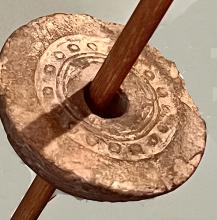tianquiztli (Mdz16v)
This glyphic element for a marketplace (tianquiztli) doubles as the place name Xaltianquizco. We have left the sand in the middle, because it is possible that a market could have sand in the middle. The viewer is looking down upon the market from a bird's eye view. The market glyph is round, with concentric circles and texturing or patterns in the inner circles. The outer circle has pairs of hash marks.
Stephanie Wood
The market in Cholula, as shown in a map from 1581, has a rectangular (not round) space marked "tianguis." Marketplaces were nearly synonymous with central squares or plazas in other cultures, but in Mesoamerica they also had judges or other officers present to ensure the smooth and fair operation of transactions. Sahagún also observed (see the quote in our Online Nahuatl Dictionary) how the tlatoani (or tlahtoani with the glottal stop), ruler, would take care of the marketplace.
The design of the glyph for the tianquiztli here is round, with concentric circles. Berdan and Anawalt mention a "round, altarlike stone" that was placed in the center of the market, and this glyph recalls that marker (Codex Mendoza, 1992, vol. 2, 156). The name for the round, sculpted stone was momoztli, and these sacred stones could also be found elsewhere. Some of the monoliths—and parts of them—still exist today. See Leonardo López Luján and Bertina Olmedo, :Los monolitos del mercado y el glifo tianquiztli," Arqueología Mexicana 101 (2010), pp. 19–20.
The hash marks perpendicular to the outermost circle are reminiscent of the hash marks on the outer wall of the apantli (canal). Perhaps this tells us that there was a wall around the marketplace. The white circles in the black ring just inside the outermost ring are reminiscent of the circles along under the roof of a tecpan (ruler's palace), perhaps suggesting that this space was under the authority of the ruler, as noted above. In the place of the sand in this glyph (which could easily be a reference to the ground inside the market), the glyph for tianquiztli from folio 58 recto of the Codex Mendoza has the inner ring with the circles painted red (a color that is often found on architecture). This glyph from folio 58 also has a smooth purple color in the center in place of the sand; purple is the same color used for glyphs of tlalli (earth, dirt, land). The tianquiztli glyphs in the Matrícula de Huexotzinco show a collection of footprints going every which way in the inner circle, capturing our imagination of the human activity so prevalent in markets.
In Nahua culture, the word tianquiztli was also applied to a constellation, which may have been owing to some coincidence of shape between the standard marketplace and the arrangement of the stars (citlalli) that made up the constellation.
Stephanie Wood
xaltianquizco. puo
Xaltianquizco, pueblo
Stephanie Wood
c. 1541, but by 1553 at the latest
Stephanie Wood
markets, mercados, round, redondo, nombres de lugares
This spindle whorl at the Peabody Museum at Harvard appears to have a tianquiztli design. Women were spinners, and women sold goods in the marketplaces, so there is a potential for a shared interest. Might a tlacuilo have carved this design? Painting on paper and carving on stone were both known to share in the "cuil" root (in tlacuilolli and tetlacuilolli, for instance). Photo by Stephanie Wood, May 2023.

xal(li), sand, https://nahuatl.wired-humanities.org/content/xalli
tianquiz(tli), market, https://nahuatl.wired-humanities.org/content/tianquiztli
Codex Mendoza, folio 16 verso, https://digital.bodleian.ox.ac.uk/objects/2fea788e-2aa2-4f08-b6d9-648c00..., image 43 of 188.
The Bodleian Libraries, University of Oxford, hold the original manuscript, the MS. Arch. Selden. A. 1. This image is published here under the UK Creative Commons, “Attribution-NonCommercial-ShareAlike 3.0 License” (CC-BY-NC-SA 3.0).



